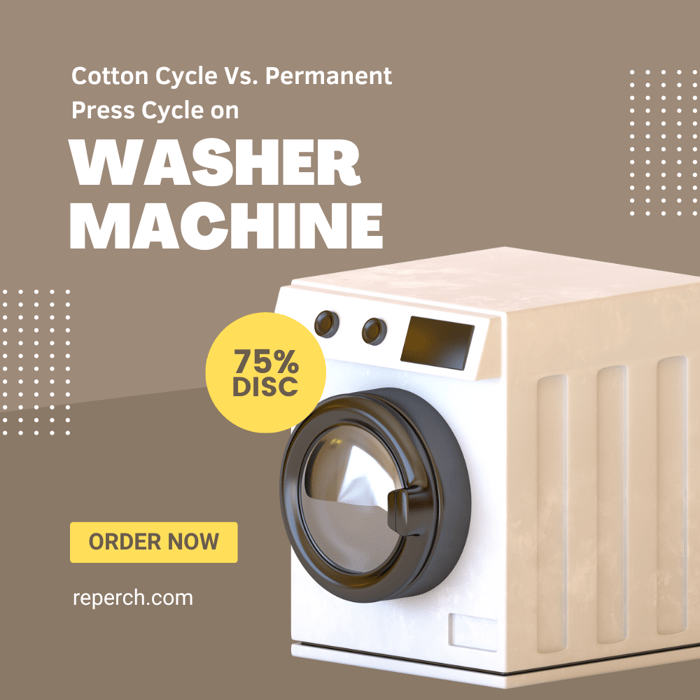Selecting the appropriate wash cycle is crucial for maintaining the quality and longevity of your clothes. Understanding the differences between the cotton and permanent press cycles can help you make informed decisions, ensuring that your garments receive the best care possible. This guide explores the unique features, benefits, and best practices for using these cycles.
Understanding the Cotton Wash Cycle
We tailor the cotton wash cycle to clean durable, natural fabrics, such as cotton. It's often the default setting for many everyday garments due to its robust cleaning capabilities.
Features of the Cotton Cycle:
Higher Agitation: To effectively remove dirt and stains, the cotton cycle employs a vigorous level of agitation. Cotton fabrics are known to trap grime, necessitating a strong cleaning action.
Longer Duration: This cycle tends to be longer compared to others, ensuring a thorough clean.
Variable Temperatures: Depending on the soiling level and fabric type, the temperature can range from 40°C for normally soiled items to 90°C for heavily soiled whites like towels and bed sheets.
High Spin Speed: To efficiently extract water from the highly absorbent cotton fabric, the cycle uses a faster spin speed, which also helps to reduce drying time.
Benefits of the Cotton Cycle
Deep Cleaning: The combination of high agitation and extended cycle time produces a deep clean, making it ideal for heavily soiled items.
Effective Stain Removal: Higher temperatures help to break down and remove tough stains.
Fabric Durability: Cotton fabrics can endure the rigorous action of the cotton cycle, maintaining their integrity while coming out fresh and clean.
Best Practices for Using the Cotton Cycle
Sort by Fabric Type: Only use this cycle for 100% cotton items to prevent shrinkage or damage to blended fabrics.
Temperature Considerations: Use lower temperatures for colored items to prevent fading, and higher temperatures for whites to ensure thorough cleaning.
Avoid Overloading: Overloading the washer can reduce the effectiveness of the wash and increase wear on fabrics.
Understanding the Permanent Press Cycle
A variety of fabrics, including synthetic blends and lightly soiled garments, can benefit from the permanent press cycle's design to reduce wrinkles.
Features of the Permanent Press Cycle:
Gentle Agitation: This cycle uses less agitation than the cotton cycle, preventing excessive wrinkling and reducing fabric stress.
Warm Wash, Cool Rinse: The cycle typically starts with warm water to relax fabric fibers and switches to cool water during the rinse phase to prevent wrinkles from setting.
Medium Spin Speed: Compared to the cotton cycle, a slower spin speed ensures gentle treatment of fabrics while still removing enough water to reduce drying time.
Benefits of the Permanent Press Cycle
Wrinkle Reduction: Gentle agitation and temperature control help to minimize wrinkles, reducing the need for ironing.
Fabric Preservation: Lower temperatures and gentle handling help maintain the color, texture, and shape of fabrics, making it ideal for synthetics and blends.
Energy Efficiency: The use of lower temperatures makes this cycle more energy-efficient, helping to save on utility bills.
Best Practices for Using the Permanent Press Cycle
Sort by Fabric Type: Ideal for synthetic fabrics like polyester, nylon, and spandex, as well as blends and lightly soiled natural fibers.
Temperature Settings: Stick to the recommended warm wash and cool rinse settings to maximize wrinkle reduction.
Prompt Removal: Remove clothes from the washer immediately after the cycle ends to prevent wrinkles from setting in.
Comparing Cotton and Permanent Press Cycles
Understanding the differences between these two cycles can help you choose the best one for your laundry needs.
Cotton Cycle:
Best For: durable fabrics like cotton, heavily soiled items, and linens.
Agitation: High
Temperature: 40 °C to 90 °C
Spin Speed: High Cycle Duration: Longer
Permanent Press Cycle:
Best For: synthetic fabrics, blends, and lightly soiled items.
Agitation: Gentle
Temperature: warm wash, cool rinse (30°C to 40°C)
Spin Speed: Medium Cycle Duration: Shorter
Choosing the Right Cycle for Your Clothes
Check Care Labels: Always refer to the garment's care label for recommended washing instructions.
Consider Fabric Type: For sturdy, natural fabrics, use the cotton cycle, while for synthetic and blended fabrics, use the permanent press cycle.
Assess Soil Level: For heavily soiled items, the cotton cycle is more effective, while the permanent press cycle is suitable for lightly soiled garments.
Maintaining Your Washer
Regular maintenance of your washing machine ensures optimal performance for both cycles.
Clean the Drum: Regularly clean the drum to prevent residue buildup.
Check Hoses and Filters: Inspect hoses and filters for clogs or damage.
Use the Right Detergent: To avoid over-sudsing, use detergents designed for your specific washing machine type (HE or standard).
Conclusion
Choosing between the cotton cycle and the permanent press cycle in your washing machine depends on the fabric type and the level of soil on your garments. Understanding the unique features and benefits of each cycle allows you to make informed decisions that will extend the life of your clothes and keep them looking their best.
Whether you're tackling heavily soiled cotton items or delicate synthetics, selecting the right cycle is key to achieving the best laundry results.








